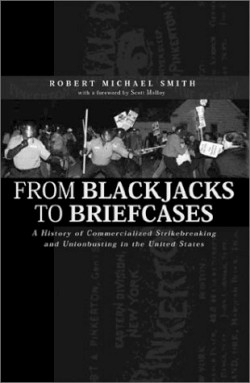From Blackjacks to Briefcases
“Any company that gets a union deserves it, and you deserve the one you get.” That statement, made by labor expert Charles Hughes in 1977, typified the anti-union sentiment that has prevailed in America since the mid 1800s. The author, a history professor at Sinclair College who has written a number of articles on labor relations, makes very clear his pro-union views in this historical depiction of commercialized strikebreaking and union busting in America since the Civil War. Although today’s working conditions may be a far cry from those in the last century, and the violence long associated with union uprisings is minimal today, Smith illustrates through historical facts that methods of union busting differ “little from those of the first part of the twentieth century.”
The book chronicles in detail the history of strikebreaking, beginning in the late 1800s when employers began turning to private policing agencies to quell labor disputes. Unregulated, unprofessional, and unruly, these “mercenaries,” as he calls them, often “exacerbated an already volatile situation.” This trend began with the Pinkerton Agency night watchmen, who evolved from armed guards protecting businesses at night to militant guards brought in for labor disputes, often clashing violently with striking workers. Jack Whitehead’s idea of organizing an army of professional strikebreakers earned him the title of “King of the Strikebreakers.” Others, such as James Farley and Pearl Bergoff, followed suit and found the industrial strikebreaking business to be very lucrative in the early 1900s.
With the federal government’s increasing involvement in regulating labor relations via legislation, there was a shift toward less antagonistic, more covert industrial espionage activities intended to divert potential strikes. “Hookers” was a term used for agents who paid workers to sell out their union-sympathizing colleagues. Although the Oppressive Labor Practices Act of 1939 “prohibited industrial espionage, strikebreaking…and the employment of private armed guards by industrialists,” anti-union agencies provided subtle resistance. “Their operatives carried briefcases rather than blackjacks as they manipulated not only the provisions of national labor law but also the emotions of those considering unionization.” Smith sees the tactics for manipulations continuing into the new millennium and maintains that the ability of anti-union agencies to adapt to economic and social conditions will continue.
Smith’s crisp writing uses emotionally charged language and colorful descriptions to make the ongoing confrontations come alive. The book provides a surprising look at the struggles that set the stage for today’s workplace environment.
Disclosure: This article is not an endorsement, but a review. The publisher of this book provided free copies of the book to have their book reviewed by a professional reviewer. No fee was paid by the publisher for this review. Foreword Reviews only recommends books that we love. Foreword Magazine, Inc. is disclosing this in accordance with the Federal Trade Commission’s 16 CFR, Part 255.

